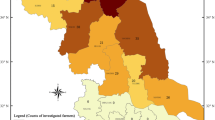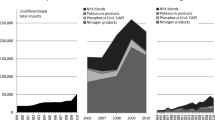Abstract
Broadcasting of prilled urea not only is technically inefficient (recovery rate is only 30% of applied N); it also causes a substantial monetary loss to farmers and a high environmental cost to society. Urea tablet deep-placement technology has shown a 25% saving in N fertilizer rates, an average increase of 400 kg ha-1 in rice yield, and a benefit-cost ratio of 4–15 in various on-station and on-farm trials in Indonesia. The technology was introduced and promoted in Java island in 1992. Hand applicators and deep-placement machines were introduced to ease the application of urea tablets. Both consumption and area coverage of urea tablets increased substantially from 1992 to 1995. Farmers recognize the economic advantage of deep placement of urea tablets, but they think that it is less practical and more labor-intensive than broadcasting of prilled urea. There are also problems of storage, distribution, and handling of urea tablets, though these can be technically overcome. Appropriate dissemination strategies and government policy support on pricing, coordination of various fertilizer industries and distributors, and credit are vital for promoting the urea tablet technology further.
Similar content being viewed by others
References
AARD — Agency for Agricultural Research and Development — Badan Litbang Pertanian (1993) Penggunaan Urea Tablet. Analisis Masalab dan Saran tindak Lanjut (Urea tablet application, problem analysis and recommendation). (unpubl.)
AARD — Agency for Agricultural Research and Development — Badan Litbang Pertanian (1996) Perspektif penggunaan dan pengembangan pupuk urea dalam peningkatan produksi pertanian (Perspective of urea tablet application in increasing agriculture production). (unpubl.)
Bimas (1995) Pelaksanaan program urea tablet TA 1995/1996 (Urea tablet implementation program 1995–96). Seasonal report
CASER — Center for Agro Socio-Economic Research (1996) Annual report on technology assessment. CASER, Bogor, Indonesia
Center for Agricultural Machinery Development (1996) Government policy support for technology adaptation and promotion: a case study of urea tablet deep placement technology in Indonesia. (unpubl.) 10 p
CSAR — Center for Soil and Agroclimatic Research (1996) Penggunaan pupuk N, P. dan K secara efisien pada lahan sawah. (unpubl.)
Delima A H (1996) Fertilizer policy in Indonesia. 'Paper presented at the Regional Workshop on Fertilizer Policies and Subsidies
Wetselaar R, Sri Mulyani N, Hadi Wahyono, Prawirasumantri J & Damdam A M (1984) Deep point-placed urea in flooded soils: research result in West Java. Proceedings of a workshop on urea deep-placed technology. AARD — IFDC
World Bank (1993) Fertilizer pricing in Indonesia: some possible options in 1993. (mimeogr.)
Author information
Authors and Affiliations
Rights and permissions
About this article
Cite this article
Pasandaran, E., Gultom, B., Sri Adiningsih, J. et al. Government policy support for technology promotion and adoption: a case study of urea tablet technology in Indonesia. Nutrient Cycling in Agroecosystems 53, 113–119 (1998). https://doi.org/10.1023/A:1009705813669
Issue Date:
DOI: https://doi.org/10.1023/A:1009705813669




